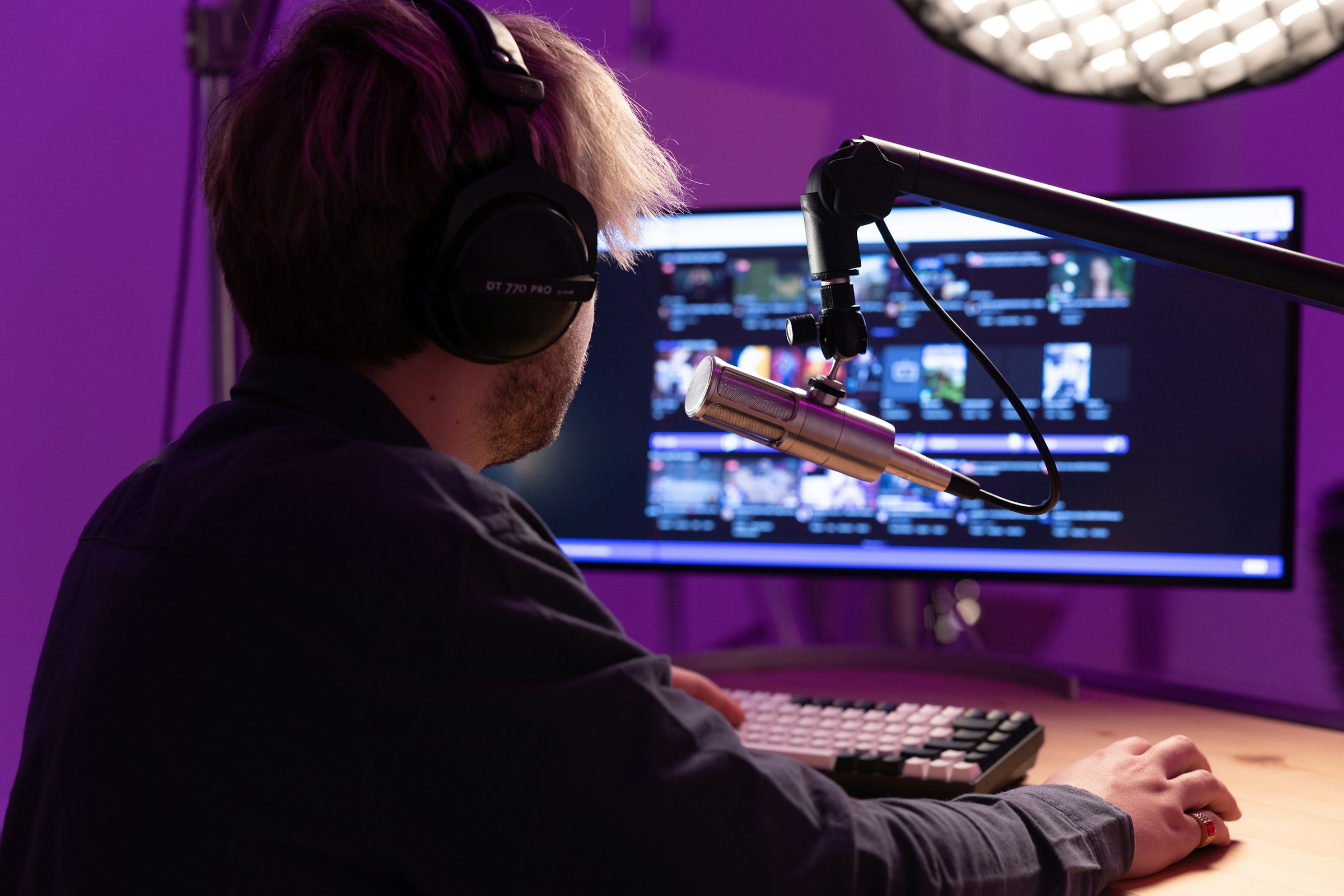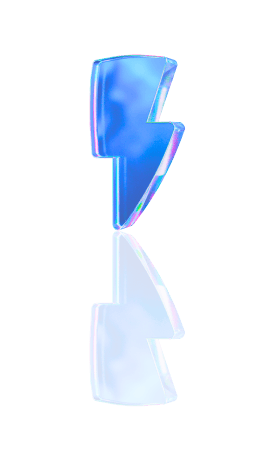You’ve probably seen the rush of interest in short-form content like TikTok and Instagram Reels. You might even be curious about trying your hand at becoming a content creator. But if you’ve ever opened these apps and felt overwhelmed by all the options, you’re not alone. Knowing where to start and how to get noticed in all the noise can be challenging. This guide will show how to be a content creator, focusing on short-form content to help you get started and reach your goals, like creating viral short videos.
One of the biggest challenges of creating short-form content is creating the content. Crayo AI's clip creator tool makes this step more accessible by helping you quickly turn your ideas into videos. The best part? You don't have to start from scratch. Clip creator uses artificial intelligence to generate video scripts based on your input and helps you create better short-form videos faster.
Table Of Contents
What Is A Content Creator?

A content creator produces written, graphic, video, or audio materials for an audience. The term generally refers to digital content creators who make entertaining or educational materials for websites, social media networks, and video and image platforms. This content can be incredibly varied. Examples include:
Articles
Blogs
Apps
Games
Videos
Images/graphics
Photographs
Newsletters
Emails
Ebooks
And more
As the above list suggests, many content creators have their niche, medium, and strategies.
Related Reading
• How to Record Streaming Video
• Video Content Creator
• Video Content Creation
• How to Make a Short Video
• Content Creator Tools
• Content Creation Software
• Content Creation Apps
Types of Content Creators

The Influencer: A Big Fish in a Sea of Content Creators
Influencers have mastered social media, building a personal brand to attract followers and shape their opinions, behaviors, and buying decisions. While influencers can be found in almost every niche, from science and technology to health and fitness, their ability to influence and engage with followers is a defining characteristic. The most successful influencers tend to be individuals who have already achieved fame in another field and convert that into social media followers.
Cristiano Ronaldo, for example, has built the largest following on Instagram thanks to his success on the soccer pitch. Some influencers have become famous purely from their internet personalities, however. The best example is Khabane “Khaby” Lame, a former factory worker who found success through lifehack parodies on TikTok. Any content creator who builds a large enough personal following is an influencer.
The Blogger: The Original Content Creator
Bloggers regularly publish posts to inform, entertain, and engage their audience. There are millions of blogs online today, with WordPress alone believed to host around 60 million unique blogs. The line between blogger and publisher can be hard to define, especially once a blog has achieved a certain amount of success. For example, Techcrunch began life in 2005 as a blog about dotcom start-ups, while Gizmodo started as a single-writer tech blog in 2001.
Some estimates suggest the number of blogs is much higher at 600 million, but that comes down to how we define blogs. For example, if we include microblogging in the mix and count Tumblr’s more than 500 million accounts, we’d also need to include Twitter and Instagram, expanding the count into the billions.
The Vlogger: A Video Blogger
Vloggers, a portmanteau of “video” and “bloggers,” tend to produce video content for social media networks and video hosting sites. They make short—and long-form content covering many topics, from lifestyle to health and fitness. Casey Neistat is one of the most successful lifestyle vloggers on the planet, amassing more than 12 million subscribers on YouTube. On TikTok, meanwhile, #dailyvlog has more than 38 billion views and is still counting.
The Podcaster: The New Kid on the Block
Podcasting is a versatile platform for storytelling and sharing knowledge and has grown in popularity thanks to its suitability as a supplementary activity. People listen to podcasts while commuting, exercising, and working in much the same way they listen to music. Joe Rogan is the biggest name in podcasting, achieving fame from his show The Joe Rogan Experience that outstrips that from his work as a comedian, TV host, and UFC commentator.
The Content Marketer: A Stealthy Creator
While not commonly perceived as content creators, content marketers also fill this role for companies worldwide. Many of the biggest brands use blogs as content marketing. The companies hire a strategic content creator to help them develop a comprehensive plan to achieve their specific goals. This individual produces content aligned with the company’s brand values and as part of a broader strategy.
One example is Etsy, which has an in-house content team dedicated to producing content that resonates with the eCommerce company’s audience. These creators can also serve as brand social media managers, handling tasks such as content creation, campaign planning, social listening, and managing social media accounts to maintain audience engagement. Wendy’s is famous for giving its social media team unprecedented creative freedoms.
How Crayo AI Works
We are looking to create short videos that get attention. Crayo AI is the fastest way to develop brief videos. Create unlimited short videos at once. Crayo even auto-generates captions, effects, background, and music for you. Take advantage of the opportunity of a lifetime and make easy money with the Tiktok Creator Fund program. Go from ideas to short videos in seconds:
Write an outline/prompt,
Customize the style (select a background video, voice narrator, and music from Crayo’s free templates),
Finish and export! Go viral, make money, and make clips in seconds with Crayo.
Try Crayo’s free clip creator tool today — just click the ‘Try Now’ button on our homepage to get started. No account is required! Go from prompt to viral shorts videos in minutes with Crayo.
How Do Content Creators Get Paid

1. Ad Revenue: How Creators Earn Money from Ads
Content creators make money from ads. They can earn ad revenue from their websites and content hosting platforms like YouTube. Depending on the creator’s content type, various ways exist to serve ads and earn income. For example, a creator could display ads on their website, apps, and newsletters. They could serve native ads on social media platforms, video ads on platforms such as YouTube or Twitch, and audio ads during podcasts or between songs.
2. Sponsorships/Brand Partnerships: How Creators Get Paid to Promote Products
Brands pay content creators to promote a product or service in a way audiences find relatable. This type of content requires the creator’s editorial input to ensure it engages their target audience. Examples include general channel and site sponsorships, product overviews and reviews, guest posts and collaborations, hosted events or experiences, and webinars and workshops.
3. Affiliate Marketing: How Creators Earn Commissions from Products
Content creators can integrate unique affiliate links or brand promo codes into suitable content — such as listicles — to earn a small commission from associated sales. These links can also appear in product reviews, tutorials, and guides.
4. Merchandise: How Selling Products Earns Creators Income
Selling merchandise—such as branded clothing, accessories, books, eBooks, or courses—is another popular source of income that can help build brand loyalty.
5. Subscriptions: How Creators Earn Revenue Regularly
Platforms like Patreon allow content creators to offer exclusive content to audience members willing to pay a monthly fee.
6. Public Speaking/Consulting: How Creators Monetize Their Expertise
Content creators who are experts in their field can earn money through public speaking engagements, running online workshops, or advising a business in a particular area.
7. Content Licensing: How Creators Get Paid for Their Work
Brands can also license a creator’s work for advertising or educational material. This can be a lucrative passive income source.
Is Becoming A Content Creator Easy?

The Truth About Being a Full-Time Creator
Being a content creator sounds like a dream come true, right? Even so, if you want to make this passion your job, you need to be prepared for the hard truth of what it means to be a full-time creator. While it’s true that you get to do what you love and express your creativity, being a content creator is a lot of work. You can’t just create content all day. There are also administrative tasks, audience engagement, and business operations. To be a full-time creator, you must be ready to tackle these responsibilities head-on.
Get Comfortable With Imperfection
When starting something new, it’s only natural to want to be perfect at it right away. However, this is an unrealistic expectation — especially for content creation. Like any job, becoming a full-time creator comes with a learning curve, and you won’t get everything right on the first try. You’ll probably be pretty bad at it when you begin. That’s okay! Embrace the process and allow yourself to improve with time. When you look back on your early work, you’ll likely see how much you’ve grown.
Do not let perfectionism hold you back from putting yourself out there and getting started. You have to start somewhere, and if you wait too long because you’re worried about not being good enough, someone else will get ahead of you. Remember…all full-time content creators started somewhere.
11 Practical Tips On How To Be A Content Creator Successfully

1. Utilize Crayo AI for Video Content Creation
Crayo AI offers one of the quickest methods to produce engaging short videos. With Crayo, you can generate countless videos simultaneously. The tool even auto-generates captions, effects, backgrounds, and music. Take advantage of this opportunity to create content and make easy money with the TikTok creator fund program.
The platform lets you quickly transition from ideas to short videos. First, write an outline or prompt. Next, customize the style by selecting a background video, voice narrator, and music from Crayo’s free templates—finally, finish and export. With Crayo, you can start going viral, making money, and creating clips in seconds.
Try Crayo’s free clip creator tool today. Click the ‘Try Now’ button on our homepage to start. No account is required. You can go from prompt to viral short videos in minutes with Crayo.
2. Remain Authentic to Your Brand or Niche
Once you discover your brand or niche, remain faithful to it. Producing content on a subject that completely deviates from your area of expertise can be confusing and ineffective. The material you share should feel like a natural fit. You should be able to discuss the topic confidently and with genuine passion.
Success as a content creator hinges on trust and authenticity. People follow creators and influencers because they feel connected to them and believe they have their best interests in mind. If something you post feels off-brand, your audience won’t engage. So, be strategic about your content and the deals you accept.
3. Stay Abreast of Trends in Your Industry
Creating content that resonates with your target audience requires staying current in your industry. This helps you understand what’s happening and how that shapes your audience’s mindset. It also lets you react quickly and get in on trending topics or memes to stay relevant. Also, follow suit and ask your audience what they read and watch. By discovering where your audience spends time online, you can learn more about the topics and types of content they’re drawn to.
4. Write Regularly
As content thought leader and author Ann Handley says, “Everybody writes.” Successful content creators understand the importance of exercising their writing muscles, even if they’re not bloggers or writers by focus. Doing so helps flesh out ideas and identify nuggets that could come to fruition later. It is also needed for creating video scripts, podcast notes, and snappy post captions.
Get in the habit of writing by doing it daily or every other day. I‘m not saying you must write a polished, 1500-word essay on an industry-relevant topic daily. Rather, set aside 10 or 15 minutes to jot down some thoughts and ideas.
Content creator Zak Sherman shared his daily writing routine, demonstrating that you don’t need to write essays to practice writing. Even sending an email can be an exercise in crafting your words and finding your voice.
5. Study Your Audience
Content creators are often at the mercy of their audience; sometimes, those needs and expectations can feel limiting. But ultimately, your audience is why you have the platform and influence you do. You‘ll find new opportunities to help and create if you continuously listen to them. One of the most essential qualities of all successful content creators is that they know their audience inside and out. Keep a pulse on yours. Tracking and analyzing specific metrics can help determine if your content resonates with your audience.
For instance, a high open rate tells you your subject line speaks to your subscribers if you have a newsletter. A high click-through rate lets you know that people wanted to know more about what you wrote about. Look for critical behaviors, interests, and trends, and respond accordingly with your content. If you’re still stuck, ask your audience directly.
Tools like SurveyMonkey or even Instagram Polls and Question Stickers make it easy to reach an engaged audience. The people who are genuinely invested in your content and brand will be more than happy to share feedback.
6. Curate Relevant Content from Others
There’s no shortage of people curating content these days. Curation is built into most platforms in the form of “shares,” “retweets,” and “repost with your thoughts.” But successful content creators know it’s not enough to republish relevant news as is simply. Sharing how the information is relevant to you is critical.
Freelance writer and content creator Kat Boogaard offers a weekly newsletter to subscribers who want her tips and insights on freelancing. One section of the newsletter is dedicated to other relevant resources. Get in the habit of curating content when you have something valuable to add.
7. Offer Solutions and Not Just Commentary
While sharing your thoughts is essential, don’t stop there. The people consuming your content aren't interested in just hearing you talk — at least not all the time. They come looking to satisfy specific needs. Provide actionable tips and walk them through the solutions you’re suggesting. This is a tip Stylist Nina Walder regularly implements in her content.
Here, you’ll notice she verbally tells viewers to “save and follow for more tips.” She also includes steps to access her free course in the caption. This is similar to what content marketers do when publishing an article, ending with a call-to-action to a relevant offer. We give readers value through the article content and give them direction on what to do next with the offer.
8. Understand Your Metrics and Key Performance Indicators
I can’t lie to you: I don’t like metrics. I often try to run from them, but they catch up to me as they’re crucial to reaching any goal. That includes becoming a successful content creator. Publishing content doesn’t mean you’ll automatically catapult to fame. Instead, your audience and impact will hopefully improve and grow slowly.
Tracking KPIs is how you monitor that growth is happening and ensure that it does. Let me explain. A KPI is a specific metric you've chosen to measure how well your content is doing against your goals. For example, if I want to reach more people on YouTube, my KPI may be channel subscribers. To reach my goal, I would:
9. Build an Active Community
Your goal as a content creator shouldn't just be about reaching as many people as possible but also turning these people into loyal fans. In other words, posting content isn’t enough. You need to get involved with your audience. This helps establish strong relationships and make your medium feel more like a tightly-knit community rather than just a place to post content. If you plan to develop a social presence, don’t hesitate to engage with your followers actively.
Regularly reply to comments and create polls asking followers about their opinions regarding specific topics. This lets followers know you genuinely care about them and makes them more likely to interact with you in future posts — it boosts your overall engagement rates, which might land you some brand deals.
10. Network at Every Opportunity
Great content creators know they didn’t get where they are today alone. It’s also thanks to those who taught, inspired, and pushed them to think differently. They know that there is always more to learn and to be open to new ideas. Networking forces you to do just that. It‘s a time to connect and listen to outside viewpoints.
Take every opportunity to get in the room with fellow creators and learn from them. That means online (they aren't called social networks for nothing) but also in person. Attend conferences, meet-ups, and workshops. Have business cards or your QR codes handy to stay in touch. These connections can lead to learning and professional opportunities.
11. Question Everything
Great content creators are naturally curious about their existing knowledge and the world around them. It's these thoughts that lead to engaging content. So, get in the habit of questioning the status quo. Pro Tip: Don’t be afraid to play devil's advocate. Taking a less popular view on a topic can be difficult, but it helps you stand out and attract an audience interested in what else you have to say. Critical thinkers make great content creators.
Related Reading
• Best Short Video
• Short Form Videos
• Short Form Video Content
• Video Content Distribution
• Short Form Video Strategy
• Content Creator Equipment
• Short Form Content Agency
• Short Form Video Trends
• Content Creator Apps
• Short Form Video Platforms
• Video Content Creation Services
10 Mistakes To Avoid As A Content Creator

1. Crafting Content for Yourself Instead of Your Audience
When we first started creating content at our agency, our priority was on the pieces we wanted to make. We position ourselves as thought leaders and showcase our expertise. The problem? We weren’t thinking about the people we were trying to connect with. Our content wasn’t solving their problems or educating them on the things they were interested in. Unsurprisingly, it wasn’t connecting that well. Unfortunately, this is the number one mistake we see brands making repeatedly.
The Fix
To create engaging content, you must understand the people you’re trying to reach and what they need. Start by creating marketing personas that identify their demographic and psychographic attributes.
To get the info you need, craft your personas, conduct customer surveys, chat with your sales team (they have a direct line to customer problems), comb through in-house data, or shoot off a quick email to ask a client what’s on their mind. This will help you brainstorm much better ideas that serve each persona. This is hands down the best way to develop content ideas that provide real value. (Also, doing this will put you ahead of the curve. Surprisingly, 45% of marketers don’t vet their ideas through personas, according to CMI’s 2019 B2B Content Marketing report.)
2. Ignoring Your Content Strategy When Brainstorming Ideas
Personas are a beneficial tool for guiding brainstorms, but it’s easy to focus only on what people want rather than how that content will support your larger goals.
For example, one of our data visualizations once reached a million views on Reddit overnight. People loved it, but it didn’t convert because it wasn’t aligned with our content strategy. If you’re in the same boat, you must ensure your ideas work for your personas and goals.
The Fix
You want your content to move people along the purchase path, meaning they need to hear the right things at the right time. To help align your messaging, map your buyer’s journey. This will help you identify your customers' pain points at each stage and determine how to position yourself as the solution.
Additionally, to ensure you have compelling content, write out the idea, who it’s for, how it addresses a pain point, and what action you want them to take after engaging with the content.
3. Neglecting the Potential of Storytelling
The story is the key to connecting to people’s emotions. It captures their attention and personalizes their experience, creating a deeper relationship. However, many brands overlook the story, thinking they can just throw out a few stats in an infographic or create a brand-centric e-book. This content is much less exciting and, therefore, less effective.
The Fix
No matter the medium (infographic, video, interactive, etc.), center it around a narrative. This may be exploratory, allowing people to reach their conclusions, or a guided narrative, where you guide them to a specific conclusion. Either way, you need to know the hook and resolution.
4. Waiting Too Long to Consider Format
Even if you’ve done your due diligence: built personas, identified pain points, solution, messaging, and story, you might be tempted to plunge in and release your creativity to bring your great idea to light—without thinking of the form that idea will take. We were guilty of this early on. Worse, we’d sometimes instantly decide on a specific medium without questioning whether it was right.
Thus, we’d rush to turn an excellent data set into an infographic when an interactive, video, or written article might have been the best choice. This lack of oversight became painfully clear when we once created a great GIF series that a significant publisher loved and wanted to promote—but its publishing platform couldn’t support it.
The Fix
Remember that the medium is just as important as the message. Once you have vetted your ideas according to strategy, explore the most effective medium.
5. Overlooking Distribution
There is nothing more frustrating to your promo team than getting looped in on a finished piece of content with no heads-up. Without a plan to distribute content or understanding where it’s meant to live, it’s harder to promote. It’s also important to remember that not all ideas work for all channels. (Remember our GIF fiasco.) Without a vision for your distribution strategy, your content will be less effective.
The Fix
Consider which distribution channels would best tell your story and connect with the people you’re trying to reach. (Also consider publisher and influencer preferences before you make your choice.)
6. Not Doing Substantial Research
Data is robust, so it’s such an effective storytelling tool. However, its capacity lies in its relevancy.
Back in the day, when we found a great study or data set that helped support a client’s content objectives, we would hit the ground running, smack into a wall when an updated report, more relevant source, or trending topic came to light halfway through the project. By not doing our due diligence to find the freshest data up front, we wasted time and energy trying to shift gears halfway through.
The Fix
Before you decide to move forward with an idea, build in a proper discovery phase. Research how a topic has been covered, what data is available, which information gaps are present (such as angles that haven’t been covered), and identify how you can contribute a new perspective.
7. Having A Weak Production Infrastructure
To succeed in content creation, you need more than a great idea; you need the ability to bring it to life. Unfortunately, if you don’t have a solid production process in place, it will cause a domino effect.
This happened to us in our early days. When we hit a snag in production, other projects would get put on the back burner, preventing us from creating a consistent content stream. Through much trial and error, we have refined our process and built the infrastructure needed to produce quality content consistently. We’re also constantly exploring and experimenting with technologies and organization systems to help us improve everything from collaborative brainstorms to design feedback.
The Fix
Build a content team with the right roles to keep things moving. (Luckily, this doesn’t require new hires—you can cover these roles with a two-person team.) You should also ensure everyone on your team is on board with your vision and has the resources and support needed to execute it. Planning well, adopting realistic timelines, and streamlining your process are the best ways to ensure you can follow through on your plans.
It is important to note that you are bound to make mistakes with any creative endeavor. But look at any speed bumps as opportunities to grow and improve. The payoff will be worth it if you’re resilient and learning to create content well.
8. Not Having the Necessary Skills
We certainly believe in experimentation, risk-taking, and an improve-as-you-go approach to content creation because we know that it’s easy to get paralyzed by perfectionism. However, some types of content are costly to experiment with if you don’t see what you’re doing (e.g., interactive design, motion graphics, video production). While it’s worthwhile to learn and expand, sometimes tackling this type of content creation as a true noob can waste money, time, and resources if you hit a snag or do something incorrectly.
The Fix
Bring in a pro to support or supplement your team’s skills. They can raise your content, and the knowledge exchange can be invaluable. That said, make sure you vet them appropriately.
You want to find the right creative partner, not just a gun for hire.
9. Ignoring or Overlooking Best Practices
Sometimes, you might have the essential skill to do something, but you don’t have the knowledge or experience to know what best practices will improve the viewer’s experience (or what mistakes to avoid).
For example, you can do many simple things to improve a data visualization's comprehension drastically. Conversely, simple oversights in design can skew data (and damage credibility).
The Fix
Educate yourself on trends and best practices in content creation, or call in a pro to make your content as effective as possible.
10. Forgetting Your Brand
No, you don’t want your branding to overshadow your content, but you want people to know who made it. The more consistent your branding, the more people will become familiar with it, and the more they’ll expect it and look to you as a resource. (Trust us: You’ll kick yourself if you forget to add your logo or attribution info, and your infographic goes viral.)
The Fix
Create a well-crafted, comprehensive brand identity. Most importantly, create brand guidelines that are easy to use. This will ensure consistency across content, which is especially important if you’re using an agency or freelancers.
Create Viral Shorts In Seconds With Crayo
Crayo AI is a transformative tool that simplifies and speeds up the process of creating short videos. With Crayo, you can create unlimited short videos at once, allowing you to crank out content quickly. The software even auto-generates captions, effects, backgrounds, and music. The best part? You can try Crayo for free right now.
Crayo takes the stress out of short video creation by providing users with templates and auto-generating content. To make a short video with Crayo, brainstorm a few ideas and write a quick outline or prompt. Next, customize the style of your video by selecting a background video, voice narrator, and music from Crayo’s free templates. Finally, finish your video and export it to share with your audience.
Making Money with Crayo AI
One of the main reasons to create short videos is to make money, and Crayo can help you do just that. With the TikTok Creator Fund program, you can get paid to make short videos. The platform pays content creators based on the number of views and engagement their videos receive. Use Crayo to create engaging videos and take advantage of this opportunity quickly.
Related Reading
• Content Creator Must-Haves
• Short-Form Content Marketing
• Best Content Creation Software
• Short-Form Video Examples
• Shorts Video Size
• Short-Form Video Apps
• Video Content Creator Tools
• Best Short-Form Video Editor
• Short-Form Content Platforms


